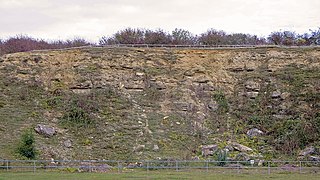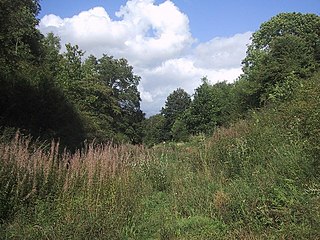The Bushveld Sandstone is a geological formation dating to roughly between 201 and 189 million years ago and covering the Carnian to Norian stages. The Bushveld Sandstone is found in Transvaal, South Africa, and is a member of the Stormberg Group. As its name suggests, it consists mainly of sandstone. Fossils of the prosauropod dinosaur Massospondylus have been recovered from the Bushveld Sandstone.
The Löwenstein Formation is a lithostratigraphic formation of the Keuper in Germany. It is underlain by the Mainhardt Formation and overlain by the Trossingen Formation. It dates back to the middle Norian.

The Inferior Oolite is a sequence of Jurassic age sedimentary rocks in Europe. It was deposited during the Middle Jurassic. The Inferior Oolite Group as more recently defined is a Jurassic lithostratigraphic group in southern and eastern England. It has been variously known in the past as the Under Oolite, the Inferior Oolite, the Inferior Oolite Series and the Redbourne Group.

The Forest Marble is a geological formation in England. Part of the Great Oolite Group, it dates to the late Bathonian stage of the Middle Jurassic.
The El Castellar Formation is a geological formation in La Rioja and Teruel, Spain whose strata date back to the possibly the Valanginian to the Barremian stages of the Early Cretaceous. Dinosaur remains are among the fossils that have been recovered from the formation.
The Ulansuhai Formation is a geological formation in Inner Mongolia, north China. Dinosaur remains are among the fossils that have been recovered from the formation.
The Ashville Formation is a geological formation in Saskatchewan and Manitoba whose strata date back to the Late Cretaceous. Dinosaur remains are among the fossils that have been recovered from the formation.
La Bocana Roja Formation is a geological formation in Baja California, Mexico whose strata date back to the Late Cretaceous, althought the precise age is unclear. Dinosaur remains are among the fossils that have been recovered from the formation.
The Glauconie argileuse is a geological formation in Europe whose strata date back to the Late Cretaceous. Dinosaur remains are among the fossils that have been recovered from the formation.
The Trichinopoly Group is a geological formation in India whose strata date back to the Late Cretaceous. It lies between the Ootatoor and Ariyalur Groups. It is broad in its southern extremity but thins as it gradually proceeds northwards as it ultimately meets the Ariyalur Group. Dinosaur remains are among the fossils that have been recovered from the formation.
The Minhe Formation is a geological formation in northwestern China, whose strata date back to the Late Cretaceous period.
The Huiquanpu Formation is a geological formation in Shanxi and Hebei provinces, China, whose strata date back to the Late Cretaceous period. It predominantly consists of purple-red mudstone, with subordinate grey-white sandy conglomerates.
The Yuliangze Formation, or Yuliangzi Formation, is a geological formation in Heilongjiang, China whose strata date back to the early-middle Maastrichtian. Dinosaur remains are among the fossils that have been recovered from the formation.

The Chipping Norton Limestone is a geological formation in the Cotswolds, England. It preserves fossils dating back to the Bathonian. Including those of dinosaurs Cetiosaurus, Megalosaurus and Cruxicheiros as well as the Tritylodontid Stereognathus. It primarily consists of ooidal limestone.



